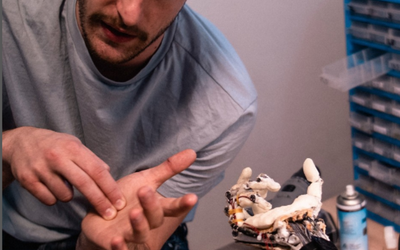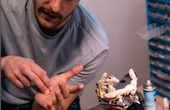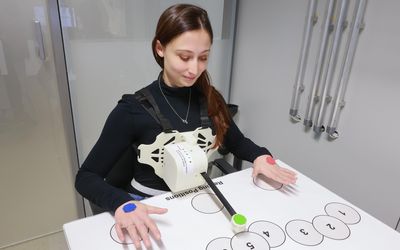MyRobotLab from InMoov
A 3D printed life sized robot with advanced human-like features.
Technical Specifications
| Actuators | Servo Motors |
| 3D Printer Compatible Size | 12cm x 12cm x 12cm |
| Project Type | Open source |
| Integrations | Camera, sensors, OpenCV, OpenWeatherMap, SwingGUI, Chatbot |
| Microcontroller | Arduino |
| Advanced Features | 3D Depth recognition, Independent Eye movements, Gesture Capturing |
Overview
First Ever 3D Printed Open Source Life Sized Robot
InMoov is a project by French sculptor Gael Langevin. The journey of this robot started in 2012 when Gael designed his first open-source prosthetic hand. From then on, he designed many innovative projects like Bionico, E-Nable, etc.
InMoov is one of the revolutionary engineering pieces as it’s the first-ever 3D printed life-sized robot available as an open-source project for robotics enthusiasts. So, it provides an excellent opportunity for learners, hobbyists, researchers, and manufacturers to implement ready-to-use robotic designs.
Easily Replicable Design
Thanks to its compact design requirements, the InMoov robot is a convenient option for users. It’s smartly designed so that each 3D printed part can be generated in a 12 x 12 x 12 cm 3D printer. Hence, it offers a cost-effective option for 3D printing applications in colleges, universities, and for DIY robotics lovers.
Moreover, since the robot has several independent parts as different projects, hobbyists can understand and learn the mechanics of the human body in more detail and accurately map muscle movements.
Additionally, the robot features several servo motors as internal actuators. With comprehensive documentation, each part and its mechanical and electrical schematics can be easily created without needing additional resources.
Arduino-Powered Robot with Specialized Human-Like Features
As a combination of various robotic parts, the InMoov robot features several Arduino microcontrollers, servo motors, a camera, a microphone, and many other tech tools. It features comprehensive hardware and software support that enables the robot with Advanced functionalities like:
Speech recognition using MarrySpeech, VoiceRss, LocalSpeech, IndianTts, and Polly.
Object tracking via the OpenCV library enables a pan-tilt camera to track objects.
The translator uses the Azure Translator API that translates audio input from the ears.
Chatbot by using the Globalized AliceBot fork
Web service via in-built WebGui for web sockets and web servers
Weather forecasting using the OpenWeatherMap
Voice Recognition
WikiDataFetcher for searching and knowledge enhancement
These tools ensure that the robot closely mimics the human body and provides honest feedback regarding its interaction with other humans and the environment. That’s why all robotic features are voice-activated and run on specialized voice commands.
Integrates with a Wide Range of Sensors and Modules
The robot runs on intelligent electronics and control algorithms to ensure smooth movements. For instance, the camera tracking mechanism uses a PID controller to overcome sudden jerks and provide a smooth output.
Moreover, there is an array of sensors, including:
Ultrasonic Sensor module for distance measurement and obstacle avoidance
PIR sensor for movement and human detection
Based on the electronic components and printable parts, five major parts of the robot include:
InMoov Arm
InMoov Hand
InMoov Eyelids
InMoov Head
InMoov Torso
Each part has a 3D-printable design with instructions to assemble and fabricate the robot. Therefore, it has all the essential tools to help young learners create a life-sized humanoid robot.









